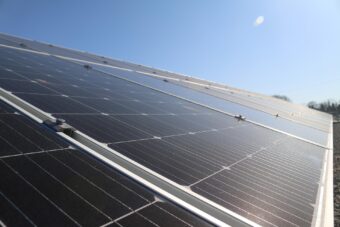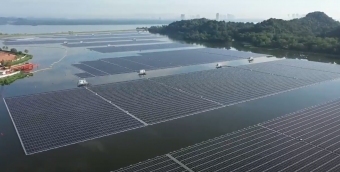
Solar energy is developing faster than all other renewable energy sources. There are different types of panels and many ways in which they can be installed. Ground and roof solar power plants are still the most popular ones. Continuous research conducted to use the sun’s energy as efficiently as possible has shown that solar panels can be placed in different areas in nature, buildings, means of transport and even on objects. For instance, there are solar windows, solar trees, and solar roof tiles. Panels are also installed in cars and there are also external batteries for charging small electronic devices that are powered by solar energy.
Solar power plants that are installed on water surfaces, the so-called floating solar power plants, are increasingly becoming a hot topic of conversation. Namely, these are solar panels that are installed on floating structures, mostly on calmer bodies of water, such as lakes or those near dams. Anchoring systems are added to them to ensure the stability of the installed panels.
Research has shown that solar power plants built in this way have several advantages over those, one might say, usual ones, that is the ones installed on the ground and roofs. Namely, experts in this field say that solar panel operations are affected by the air temperature because when the panels are heated, their efficiency decreases. This is precisely where the advantage of water solar panels lies, as water provides a natural cooling effect. The data shows that the temperature of the solar positioned on a body of water can increase their efficiency by 15 per cent.
More:
- WHAT IS THE SUN TAX AND WHY SOME COUNTRIES “PUNISH” THEIR PROSUMERS?
- GROWING NUMBER OF FLOATING SOLAR POWER PLANTS IN ASIA
- SCIENTISTS HAVE CREATED FLEXIBLE AND WATERPROOF SOLAR CELLS
Another reason why the presence of water increases their effectiveness is the albedo effect. More precisely, this effect refers to the ability of a certain surface to reflect light back and as we all know, water surfaces reflect sunlight more strongly than land ones. Thanks to this feature, the sunlight is directed back to the solar panels, which increases its amount and thus simultaneously improves the efficiency of electricity production.
However, there are also a few drawbacks that we should mention. Such projects are mostly large-scale, which means that if someone wants to produce electricity for their own needs, such as for their home, it is more practical to install them on the roof. Furthermore, not all bodies of water can be used for solar power plants, because they need to be calm. Also, the cleaning of the panels is not that easy, as it often requires more financial resources and special equipment. The panels need to be clean to be efficient.
Another questionable feature is the impact that such power plants have on the aquatic ecosystem. Some studies have shown that they can have positive effects. Given that they create a shading effect, i.e. create a shadow on the surface on which they are placed, solar panels contribute to lowering the water temperature and thereby reducing the degree of its evaporation. This is especially important in areas that are arid and where there is a risk of water shortage. Second, by preventing sunlight from penetrating below the surface of the water, algae growth is reduced. The so-called algal bloom, which can cause negative consequences for the aquatic ecosystem, occurs due to the excessive availability of sunlight and nutrients, which are reduced by the presence of floating solar power plants.

However, if such power plants are installed without special precautions, they can hurt the living world. As mentioned earlier, the presence of the panels affects the temperature of the water as well as other characteristics, thus changing the exchange of oxygen and carbon dioxide, wind effects and the amount of sunlight that penetrates below the surface. To keep these changes under control, there is a limit on the degree of coverage of water areas. Other rules should also be noted, such as that floating solar systems should be installed at least 40 metres from the shore. The coastal part is a habitat for many plant and animal species, including birds, beavers, insects and others. Given that there is still not enough research that can confirm whether and to what extent solar power plants would negatively impact this segment of biodiversity, i.e. their nutrition, reproduction and the possibility of injury, the coastal part must be left untouched.





